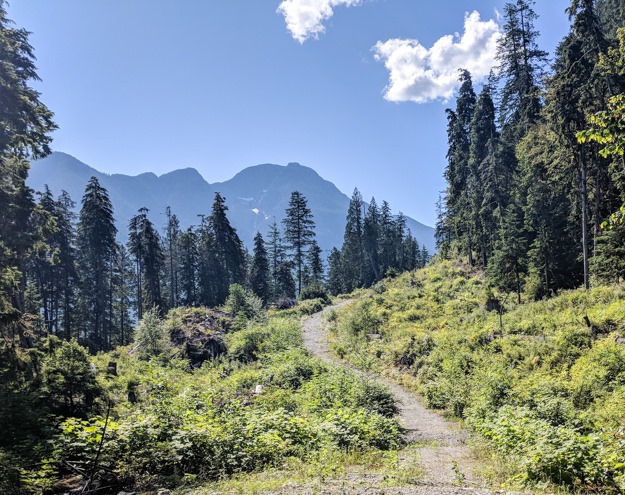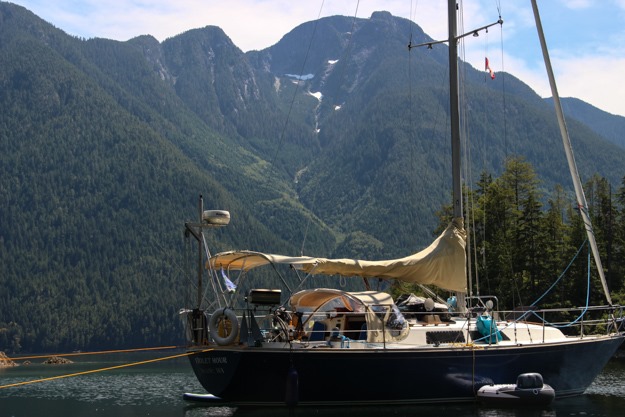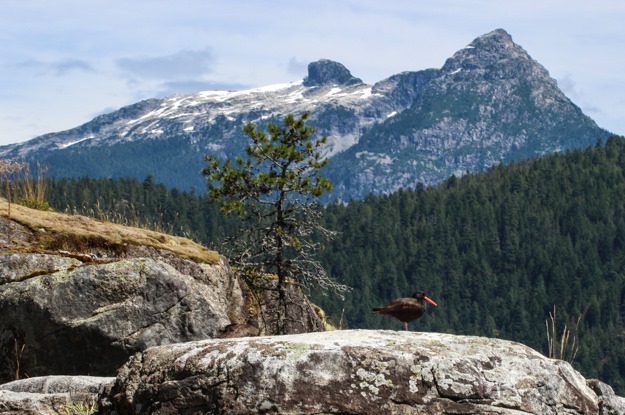In July, month four of our cruising plan, we started slowing down (intentionally) and enjoying hot weather and easy sailing. After the challenges of June, easy sailing in Johnstone, Desolation Sound and the Strait of Georgia was a welcome change.
Also it got hot – really hot, in some cases – 90F in Desolation Sound. We weren’t used to this heat, and it was great while sailing (like sailing in the tropics!) but tough the rest of the time (sailboats heat up like an oven, and good ventilation doesn’t really do much when there’s no wind).
In July we went from Port McNeil to the Gulf Islands (Tent Island, at the top of Saltspring). We only did 20 days of sailing (we had a 5 day break to attend a wedding, and 5-6 days where we stayed in the same anchorage), and took a fairly meandering route (see map below).

Blue line indicates approximate rhumb line, not actual sailed line.
We had a fast downwind sail through Johnstone Strait, and then took a loop around East Thurlo Island. We reprovisioned in Campbell River and then sailed to Desolation Sound, spending 5 days in Pendrell Sound enjoying the sun, swimming, inner-tubing, paddleboarding and hiking.
Next we sailed to Cortes Bay and then headed south in the Strait of Georgia, having very light NW winds (2-6 kts). At Tribune Bay, the wind pattern picked up to NW 15-20 but only at night – from about 8pm – 8am. Very strange, and inconvenient since it meant windy nights at anchor and windless days with very slow sailing. We spent 2 nights at Jedediah Island and some forest fire smoke moved in, making for bright red sunsets but lower visibility.
Next we headed to Nanaimo and spent 2 nights at anchor catching up on chores, reprovisioning, and hiking around Newcastle Island. Nanaimo was busy! About 100 boats in the anchorage and frequent ferries and dinghies racing about, making for choppy conditions until dusk.
The wind pattern switched to moderately strong southeasterlies as we headed south to the Gulf Islands through Dodd Narrows. The Gulfs were unlike I’ve ever seen them – SE 15-20 and pretty choppy waves (wind against current), enough to send saltwater back to our dodger. Previously we’ve only had NW wind in the Gulfs in the summer, and 20 knots was a surprise – usually it’s light wind days (5-10) with the spinnaker up.

Stats
-
- Distance as the motorboat travels: 286 nm
- Distance traveled overall (estimated): 350 nm
40% upwind, 60% downwind
- Top wind speed while sailing:
Downwind: 30 knots NW, Johnstone Strait
Upwind: 20 knots SE, Gulf Islands
- Highest wind speed at anchor: 15-17 knots (SE) at Montague Harbor, north of the beach; and 15 knots NW at Tribune Bay, Hornsby Island (a motorboat dragged here in the night, to port of us).
- Days in motion: 20
- Engine hours: 20 (~1 hour/day)
- Diesel consumed: ~8 gallons
(about 1/2 our engine hours are at near idle RPM, while anchoring, so that’s why our engine only consumed less than 1/2 gallon/hr – when we’re sailing a lot, our engine hours become more predominated by idle speeds due to harbor entry/exit/anchoring)
- # Stays in a Marina: 1 (Campbell River)
- # of Gale Warnings: 0 (Yay! That’s 10 fewer than June)
Weather
In July it got hot – really hot, in some cases. We had 90F degree days in Desolation Sound, constant sun, and of course mosquitoes. We’re softies when it comes to heat. We’re used to PNW 65F being a comfy room temperature. In 60F it’s shorts weather, in 70F it’s getting hot, 80F is awfully hot, and at 90 with no wind we start melting.
Another thing is being on a boat in 90F is different than being on land in 90 – where perhaps you go to an air conditioned office during the day, commute in a car with A/C, or live in a house/apt that is partially shaded and has fans. A boat doesn’t usually sit under trees, and it’s a small space so it heats up quickly. And when we’re cruising we’re outside in the sun nearly all day.

Sailing in 85-90F can be really fun and comfortable though – with 8-10 kts going upwind we cool off easily in our swim suits, and start to see what tropical sailing is perhaps like. 10 knots of wind is rare here in late July to August though, so we take it when we can get it, and otherwise have to motor.
Saltwater, instead of being the enemy (in typical PNW sailing, saltwater destroys your clothes’ warmth and can induce hypothermia), becomes a way to cool yourself. We’ve been jumping in the water, paddleboarding, and lounging in the inner tube.
Wind
July is typically a wind light month, particularly in the second half. We had some great fast sails at the start of the month, but in the second half it was all about using light wind to go short distances (ex, 24 nm in 7 hours – avg 3 kts). When going downwind, the spinnaker becomes our default sail.

We were only downwind about 50% of the time though. NW wind reputedly predominates in July, but in the Strait of Georgia and Gulf Islands we found it often becomes SE. We had a divergence zone in the middle where NW wind transitioned to a lull and then to SE. The SE/SW wind is from strong Strait of Juan de Fuca west wind that funnels up the Strait of Georgia. Getting through that middle lull section is tough.

I’ve been impressed by how many sailboats are making the effort to sail – about 50% of sailboats we’ve seen have been sailing when the wind is 5-10 knots, and about 60-70% of sailboats sail in 10-15 knots. Partly this is due to the fact there are far more sailboats around the Gulf Islands and Strait of Georgia – the sailboat to powerboat ratio is often close to 50/50, rather than 20/80 as it often is north of Cape Caution.
Overall July was still a great month for sailing, and being on the Inside Passage we sailed a lot more than we would’ve on the west coast of Vancouver Island. All the wind was usable, and the longest we had to motor (during windless stretches) was a peak of about 2 hours in a day.

Favorite Anchorages
Both of us said our favorite anchorage this month was Pendrell Sound. This was no surprise, as it was our favorite anchorage in 2016 too. We developed a routine during our 5 days in Pendrell, waking up with coffee in the cockpit, and then did morning yoga on the bow looking out on the mountains.
In the afternoon we’d paddleboard, swim and lounge in the inner tube in the sunny heat. Come 4:30, it was time for happy hour (the “violet hour”) and relaxing. It was a good life, to say the least. Pendrell Sound is a special place for us.


Boat Issues
- Undercharging of batteries: I noticed our lead-acid batteries, which are only 2 years old, starting to show signs of undercharging – we seemed to be getting less capacity out of them, because voltages were lower with only moderate amp hour draw down.
I ran a battery equalization while on shore power at Campbell River. The problem though is it takes 6 hours or more, and the batteries need to be monitored regularly. During the day in a marina we’re never at the boat that long because we have many chores to do, so I did it between 8pm – 2am, setting an alarm to wake up and check them. They hadn’t finished after 6 hours though so I let it time-out to get some better sleep. I’ll have to try it another time again.
We also should get another solar panel. Our 200 Watts sometimes isn’t enough to reach absorption phase now that we have hot weather and the fridge is running more.
- Tohatsu 4-stroke outboard: We continue to have issues with our new outboard. It flashes the oil pressure light at idle despite having correct oil and level, and in Nanaimo we were getting power loss a couple times. I’ve contacted Tohatsu and some forums, but no luck on how to fix it (without $400 to a local dealer and a day or two in port, which we usually don’t have time for, plus I’m not sure it’s worth the cost). Starting to wish we didn’t buy a Tohatsu.
- Jimmy Styks inflatable paddleboard: our paddleboard somehow sorta broke – the plastic slot for the stabilizing fin distorted and the fin no longer fits in properly. Sad because this paddleboard is less than 6 months old. For now I’ve duck taped it on, but am contacting Jimmy Styks.
None of these issues are serious, but I write about them because it goes to show how issues can accumulate while cruising, and it can be very difficult to find the time, money or resources to fix them. By month 4, stuff starts to break or wear out.
When not cruising, we have a lot of resources to draw upon – marine mechanics in Seattle, Internet, and time in marinas (not many outboard mechanics will visit an anchorage, and Fedex doesn’t deliver warranty returns to anchorages either – although they should get on that!). Simple problems are more difficult to fix while cruising.
Reflections
Month 4 of cruising was all about slowing down and doing shorter days or spending multiple nights in the same place. After cruising for 4 months, it’s not a vacation or short duration cruise anymore, it’s life. Traveling every day is stressful and tiring; to be sustainable sometimes you need to slow down and develop a routine.
In Pendrell Sound for 5 days we developed a great routine and had more time to focus on wellness / health things, like doing yoga and exercising every day (paddleboarding, hiking or rowing).
It wasn’t easy to slow down though. Cruisers usually move anchorages every day, and that rhythm of a new place to explore plus the adventure of the sail there is appealing. Yet it’s also stressful – every time we move our home to a new place it takes a little while to adjust. Questions run through our heads – will we be safe here and protected from incoming wind or swell? Are the boats next to us far enough away and will they drag anchor? Do we have enough scope out so that we won’t drag?
When you think about it, it’s kind of weird that cruisers move location every day. Would you go to Hawaii for a week and change hotels every day? Probably not, and that would be a lot of work. Plus you’re in frigging Hawaii – why move when there’s plenty of awesome stuff nearby to fill more than one day?
That’s kind of how we felt about Pendrell Sound – we were in our favorite place, so why move? Slowing down didn’t feel natural, but it’s important to do when cruising for long durations. Eventually though we hunger for sailing and new adventures, and it’s time to move on – that’s one of the great things about cruising, that you can go at whatever pace works for you.
One thing’s for sure and it’s that we feel really fortunate to be able to live this cruising life. Being surrounded by natural beauty every day is cathartic and rejuvenating in a way that can’t be described. After 3 months we were feeling a little tired, but at the end of month 4, we’re not ready to give this up.

